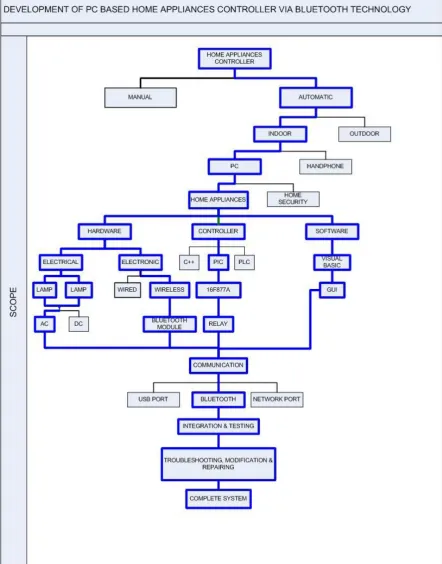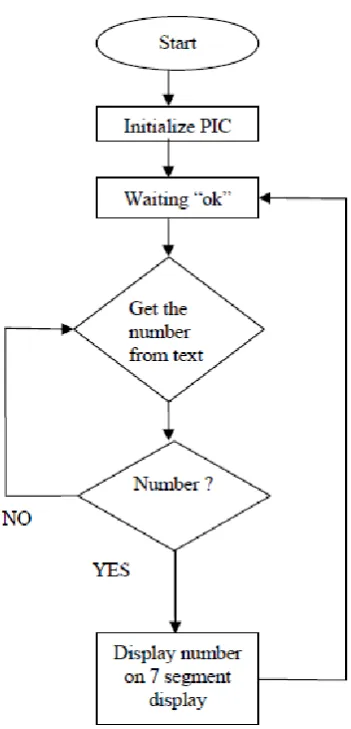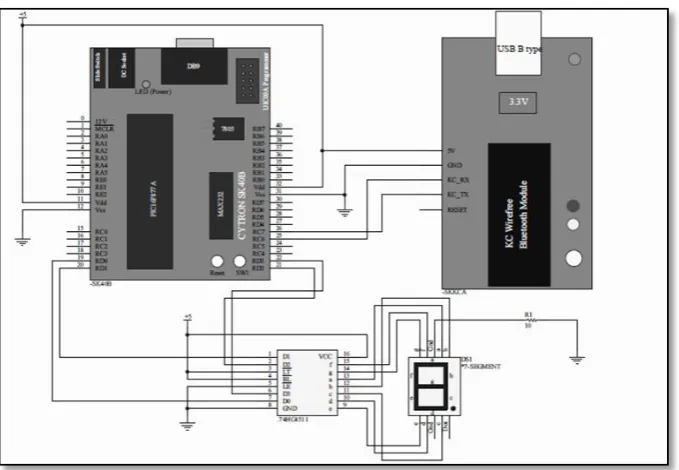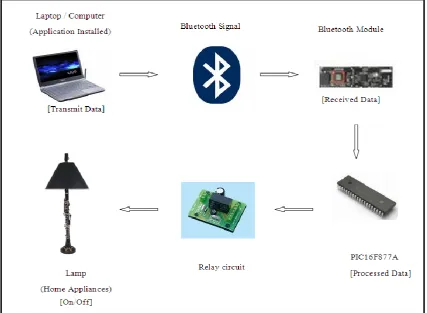Dedicated with deepest love to:
“I hereby declare that I have read through this report entitle “Development of PC Based Home Appliances Controller via Bluetooth Technology” and found that it has comply the
partial fulfillment for awarding the degree of Bachelor of Electrical Engineering (Industrial Power)”
Signature : ...
Supervisor’s Name : Mr. ZAIHASRAF BIN ZAKARIA
DEVELOPMENT OF PC BASED HOME APPLIANCES CONTROLLER VIA BLUETOOTH TECHNOLOGY
MOHD NAZRI BIN IDRIS
A report submitted in partial fulfillment of the requirements for the Degree of Electrical Engineering (Industrial Power)
Faculty of Electrical Engineering
UNIVERSITI TEKNIKAL MALAYSIA MELAKA
I declare that this report entitle “Development of PC Based Home Appliances Controller via Bluetooth Technology” is the result of my own research except as cited in the
references. The report has not been accepted for any degree and is not concurrently submitted in candidature of any other degree.
Signature : ...
Name : MOHD NAZRI BIN IDRIS
ACKNOWLEDGEMENT
ABSTRACT
ABSTRAK
TABLE OF CONTENTS
CHAPTER TITLE PAGE
ACKNOWLEGDEMENT i
ABSTRACT ii
TABLE OF CONTENT iv
LIST OF TABLE vi
LIST OF FIGURE vii
LIST OF APPENDICES ix
1 INTRODUCTION 1
1.1 Overview 1
1.2 Problem Statement 2
1.3 Objective 2
1.4 Project Scope 3
2 LITERATURE REVIEW 5
2.1 Related Project 5
2.2 System Overview 5
2.3 Software Flow Chart 6
2.4 USB Dongle Setup 7
2.5 Interface Using HyperTerminal 8
2.6 Summary For Related Project 9
2.7 Proposed System Operation 10
3 METHODOLOGY 11
3.1 Methodology Flowchart 11
3.2 Tools Used 13
3.2.2 Software Selection 16 3.2.2.1 Visual Basic Express Edition 16
3.2.2.1.1 Visual Basic Features 16
3.2.3 CCS PCWHD v4.084 19
3.2.3.1 Transfer the program to PIC microcontroller 20
3.2.4 Bluetooth 21
3.2.4.1 Bluetooth Application 21
3.2.4.2 What is Bluetooth? 22
3.2.4.3 Bluetooth Technology and Transceiver 23
3.3 Circuit Schematic Diagram 25
4 RESULT AND ANALYSIS 27
4.0 Graphical User Interface, GUI 27
4.1 Hardware 29
4.2 Analysis of the project 30
4.2.1 Analysis on Apartment house 30
4.2.1.1 Analysis Condition 1 31
4.2.1.2 Analysis Condition 2 31
4.2.1.3 Analysis on Condition 3 32
4.2.1.4 Analysis on Condition 4 33
4.2.2 Analysis on two storey house 34
4.3 Analysis Conclusion 36
5 DISCUSSION AND CONCLUSION 37
5.0 Circuit Operation 37
5.1 Discussion 41
5.2 Conclusion 44
5.3 Recommendation 44
REFERRENCE S
46
LIST OF TABLE
TABLE TITLE PAGE
3.0 Bluetooth Frequency Band 22
3.1 The Bluetooth Class Specification 24
4.0 The result for Condition 1 31
4.1 The result for Condition 2 (door opened) 31
4.2 The result for Condition 2 (door closed) 32
4.3 The result for Condition 3 32
4.4 The result for Condition 4 33
4.5 The Simplified Table For Analysis In Apartment House 33
LIST OF FIGURE
FIGURE TITLE PAGE
1.1 Scope of Project 4
2.1 The System Illustration 6
2.2 The System Circuit Schematics 7
2.3 Bluesoleil Main Window Searching For Device 8
2.4 Bluesoleil Main Window Searching For Device 8
2.5 Hyperterminal Setup 9
2.6 System Illustration for Hardware Development 10
3.1 Methodology Flowchart 12
3.2 PIC16F877A pin diagrams 14
3.3 PIC 16F877A Block diagram 15
3.4 Visual Basic Program 16
3.5 Visual Basic Launch in Windows 17
3.6 The PCW Integrated Drive Electronics (IDE) 19
3.7 PIC bootloader device 20
3.8 IC programmer graphical user interface (GUI) 21 3.9 Host to host communication through Bluetooth Transceivers 24
3.10 Circuit Schematic diagram 25
3.11 PIC16F877A Properties Windows 26
4.0 The complete GUI in visual basic 28
4.1 Complete hardware 29
4.2 Apartment House Floor plan 30
4.3 Ground floor floorplan 34
4.4 First Floor Floorplan 35
5.0 Virtual Terminal Properties 38
5.1 Circuit Simulation 38
5.3 Data ‘3’ sent 39
5.4 Data ‘0’ sent 40
5.5 Searching for bluetooth device 41
5.6 Pairing the bluetooth device with computer 42
5.7 Established Connection Between GUI and Bluetooth Device 42
LIST OF APPENDICES
APPENDIX TITLE PAGE
A CCS PCW CODING FOR PIC16F877A
MICROCONROLLER
46
CHAPTER 1
INTRODUCTION
This chapter will discuss on overview of the Development of PC based home appliances controller via Bluetooth technology. This chapter also will explain the basic understanding on the project scope and the objective of the project.
1.1 Overview
1.2 Problem Statement
In this modern era, the need of controlling home appliances by automatically by computer is very highly demand. This is due to save time and energy in case of in the middle of working with the computer to operate the manually switch “on” and “off” meaning that user do not need to leave in the middle of working just only to switch on or switch off the home appliances for example light or fans.
Besides that, cable will be replace with wireless will save the cost of wiring the house reduce the chances of short circuit to be happen. This is also will lead us to the future modern house where all the appliances are controlled wirelessly.
Thus, with this project that developed it will provide the convenience way for human to control all the home appliances for example the lights and fans is the most common home appliances that are used in our daily life.
1.3 Objective
There are 4 main objectives of this project is shown as below: • To make house appliances controlled easier.
• To implement the new Bluetooth technology application in control system. • To integrate between software and hardware.
1.4 Project Scope
The K-chart in Figure 1.1 below shows the scope of the project. From the K-chart it can be clear to understand the scope of the project that is include hardware development, software and microcontroller used.
CHAPTER 2
LITERATURE REVIEW
This chapter will be discuss on literature review including a detailed survey of the background to the project, an overview of the subject, discussion of any essential theories and a review of any important publications.
2.1 Remote Control Seven segment using USB
This project is an open source microcontroller “Do It Yourself Kit” from cytron website [2]. This PIC microcontroller based project perfectly designed for armature user to start develops the Bluetooth wireless control and learn the basic function of the Bluetooth wireless control via microcontroller PIC. By this project, the user can clearly understand on how to interface the microcontroller PIC16F877A with the KC Wire-free Bluetooth Starter Kit. The 7-segment LED display is used to show the number that typed in the text of HyperTerminal in computer.
2.2 System Overview
Figure 2.1: The System Illustration
Figure 2.2: The System Circuit Schematics
2.4 USB Dongle Setup
Before the USB dongle can be used, a communication link has to be established between the Bluetooth Module and Bluetooth Dongle using IVT BlueSoleil. Following are the steps of installing and establishing a link between the two:
• Install the software IVT BlueSoleil using CD included with the USB dongle
• Once the software has been successfully installed, plug in the USB dongle and run the software
• Switch on the power for the circuit with the SKKCA-21
• On the screen, you should be able to see a window as in figure 4.5. Click the Orange ball
in the center of the window or press F5
• Once the Bluetooth module is detected, it will appear in the window. Figure 2.3 shows the program searching for devices and Figure 4.7 shows the discovery finished.
Figure 2.3: Bluesoleil Main Window Searching For Device
Figure 2.4: Bluesoleil Main Window Searching For Device
2.5 Interface Using HyperTerminal
[image:22.595.149.480.368.602.2]Figure 2.5: Hyperterminal Setup
2.6 Summary for Related Project
From the study and review that have been made from this system. It show that this project is used window’s HyperTerminal as the interface between the computer along with the Bluetooth module and PIC16F877A. It shows that the system is not user friendly because it doesn’t have GUI (Graphical User Interface) that is harder for user to operate certain operation to PIC16F877A.
2.7 Proposed System Operation
Figure 2.6: System Illustration for Hardware Development





